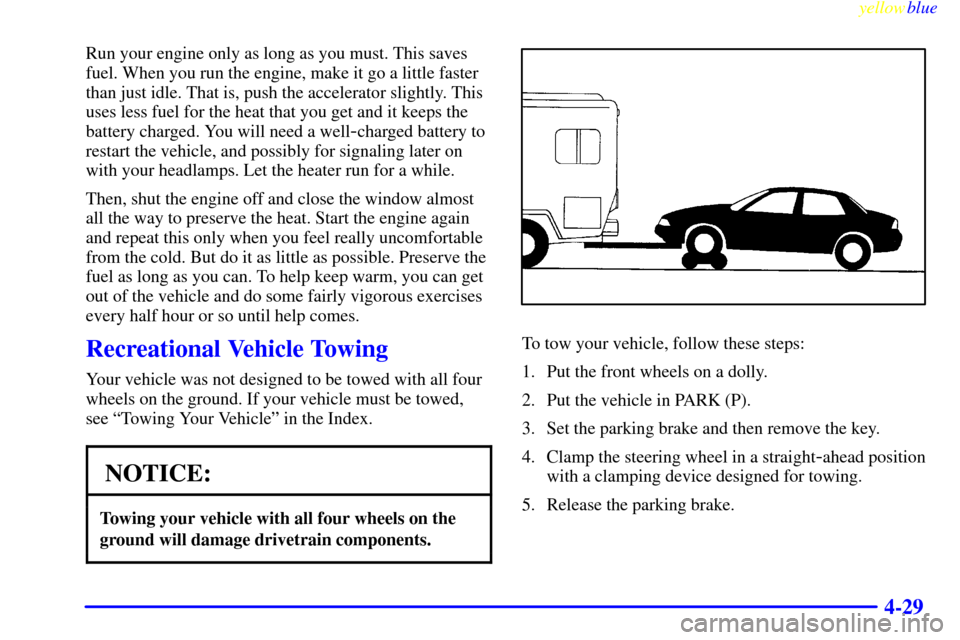Page 9 of 362

yellowblue
1-3 Massaging Lumbar (If Equipped)
Push the lumbar control, located on the outboard side of each
front seat, up for half a second to activate the massage
feature. The massage cycle will run for 10 minutes and can be
interrupted by pushing the lumbar control down briefly. The
lumbar support can be adjusted during the massage cycle by
moving the switch forward to increase support and rearward
to decrease support. The massage cycle will continue to run
even if the ignition is turned to OFF, unless interrupted.
Adaptive Seat Control (If Equipped)
The adaptive seat control is
located on the outboard side
of each front seat. Use the
power seat control first to
get the proper position.
With the ignition on, press the control up to activate the
adaptive seat. (The lumbar will automatically adjust to
your body's positioning for the duration of the trip in
four
-minute cycles.)To reshape the lower seatback, press the lumbar
control forward to increase support and rearward to
decrease support.
To turn off the adaptive seat feature, press the control
down. The seat will deflate when the adaptive seat
control or the ignition is turned off.
Memory Seat, Mirrors and Steering
Wheel (Option)
The controls for these
features are located on the
driver's door panel, and are
used to program and recall
previous settings.
Adjust the driver's seat (including the lumbar and head
restraint adjustments), both the outside mirrors and
steering wheel to a comfortable position and then press
the MEMORY SET button. Within five seconds, press
button 1.
Page 71 of 362

yellowblue
2-19
New Vehicle ªBreak-Inº
NOTICE:
Your vehicle doesn't need an elaborate
ªbreak
-in.º But it will perform better in the long
run if you follow these guidelines:
�Don't drive at any one speed -- fast or
slow
-- for the first 500 miles (805 km).
Don't make full
-throttle starts.
�Avoid making hard stops for the first
200 miles (322 km) or so. During this time
your new brake linings aren't yet broken
in. Hard stops with new linings can mean
premature wear and earlier replacement.
Follow this breaking
-in guideline every
time you get new brake linings.
�Don't tow a trailer during break
-in.
See ªTowing a Trailerº in the Index for
more information.
Ignition Positions
CAUTION:
Leaving children in a vehicle with the ignition
key is dangerous for many reasons. A child or
others could be injured or even killed. They could
operate power windows or other controls or even
make the vehicle move. Don't leave the keys in
the vehicle with children.
With the key in the ignition switch, you can turn the key
to four different positions:
OFF: This position lets you
turn off the engine and
remove the key. It doesn't
lock the steering wheel.
Page 219 of 362

yellowblue
4-29
Run your engine only as long as you must. This saves
fuel. When you run the engine, make it go a little faster
than just idle. That is, push the accelerator slightly. This
uses less fuel for the heat that you get and it keeps the
battery charged. You will need a well
-charged battery to
restart the vehicle, and possibly for signaling later on
with your headlamps. Let the heater run for a while.
Then, shut the engine off and close the window almost
all the way to preserve the heat. Start the engine again
and repeat this only when you feel really uncomfortable
from the cold. But do it as little as possible. Preserve the
fuel as long as you can. To help keep warm, you can get
out of the vehicle and do some fairly vigorous exercises
every half hour or so until help comes.
Recreational Vehicle Towing
Your vehicle was not designed to be towed with all four
wheels on the ground. If your vehicle must be towed,
see ªTowing Your Vehicleº in the Index.
NOTICE:
Towing your vehicle with all four wheels on the
ground will damage drivetrain components.
To tow your vehicle, follow these steps:
1. Put the front wheels on a dolly.
2. Put the vehicle in PARK (P).
3. Set the parking brake and then remove the key.
4. Clamp the steering wheel in a straight
-ahead position
with a clamping device designed for towing.
5. Release the parking brake.
Page 294 of 362

yellowblue
6-30
NOTICE:
�Using the wrong fluid can badly damage
brake system parts. For example, just a few
drops of mineral
-based oil, such as engine
oil, in your brake system can damage brake
system parts so badly that they'll have to be
replaced. Don't let someone put in the
wrong kind of fluid.
�If you spill brake fluid on your vehicle's
painted surfaces, the paint finish can be
damaged. Be careful not to spill brake fluid
on your vehicle. If you do, wash it off
immediately. See ªAppearance Careº in
the Index.
Brake Wear
Your vehicle has four-wheel disc brakes.
Disc brake pads have built
-in wear indicators that make a
high
-pitched warning sound when the brake pads are worn
and new pads are needed. The sound may come and go or
be heard all the time your vehicle is moving (except when
you are pushing on the brake pedal firmly).
CAUTION:
The brake wear warning sound means that soon
your brakes won't work well. That could lead to
an accident. When you hear the brake wear
warning sound, have your vehicle serviced.
Your vehicle also has electronic wear sensors that let
you know when the brake pads are significantly worn
and new pads are needed. The CHANGE BRAKE
PADS message will be displayed on the Driver
Information Center when the brake pads are worn and
need to be replaced. (See ªChange Brake Pads Messageº
in the Index.)